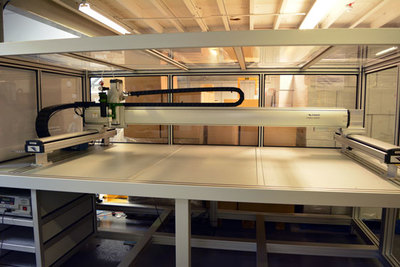
Contact Details:
INTERTRONICS
Unit 17, Station Field Industrial Estate
Banbury road
Kidlington
Oxfordshire
OX51JD
United Kingdom
Tel: +44 (0)1865 842842
Fax: +44 (0)1865 842172
Send Enquiry | Company Information

New guidance from Intertronics – How to specify a dispensing robot to increase quality and cut costs
Company News Wednesday, July 4, 2018: INTERTRONICS
Automated application of adhesives, potting compounds or encapsulants, sealants, FIP gaskets, temporary masking, lubricants, or other liquids, fluids or pastes provides productivity benefits over manual application, including consistency, speed and accuracy. As selection of a dispensing robot is sometimes a daunting task, Intertronics, a specialist adhesives and dispensing company, has compiled a short piece of guidance on how to specify a dispensing robot. The full guidance can be found on their blog at www.intertronics.co.uk/specify-robot.
When specifying a dispensing robot, it is important to understand that a so-called dispensing robot consists of four main components: the robot itself; the dispensing equipment; tooling to attach the dispenser to the robot and to hold the parts to be dispensed on; and an enclosure to protect both the robot and its users. Each of these components can be specified separately, but need to be compatible with each other to ensure a complete and fully operational system. The equipment supplier should be able to assist with this, and may have suggestions for a complete system based on the customer’s application.
The list of considerations for the components of a dispensing robot include work area, Z height, number of axes, weight of parts, weight of payload, load/unload process, accuracy, tolerance and repeatability. All of these are explained in greater detail, along with leading questions, in the full guidance.
Depending on application requirements, there are several dispensing methodologies to consider. The supplier should be able to help discern the most suitable methodology for the application and requirements, as well as with assembly and integration of the completed dispensing robot.
Once the dispensing robot has been specified, purchased and delivered, full training should be given to all users. This may be available from the equipment supplier.
Explains Intertronics M.D. Peter Swanson, “Automating the dispensing process can have significant effects on productivity and product quality. Robots, particularly benchtop robots, offer fast return on investment and a good level of capability when coupled with appropriate dispensing equipment. We have seen substantial improvements in consistency, speed, accuracy and reliability of the dispensing process with our customers who have implemented automated dispensing. This leads to cost savings in materials, production times and reduced rework.
“We have compiled “How to specify a dispensing robot” to help others toward that first step in the process, but we are also happy to walk through the specification process in detail with technology manufacturers who are considering automating their dispensing process. We can, of course, supply all of the components as a completed robotic dispensing system with process integration and training.”
For the full article “How to specify a dispensing robot”, visit www.intertronics.co.uk/specify-robot or browse Intertronics’ blog at www.intertronics.co.uk/blog. Intertronics’ website also offers case studies of companies who have used dispensing robots to improve their process and productivity.
